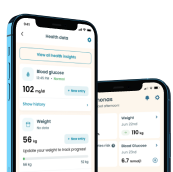Fasting and Diabetes: Can You Combine the Two?

Are you considering to try intermittent fasting (IF) to help manage your type 2 diabetes? It’s no surprise that IF has become a trendy buzzword. The research on this subject is growing rapidly, and studies are starting to show just how beneficial it can be for weight loss, cardiovascular disease, and even cancer prevention. Should you try to combine fasting and diabetes?
Keep reading to find out all you need to know about intermittent fasting for type 2 diabetes.
What is intermittent fasting
Most people assume that IF is a type of diet, but it’s more of a variety of different eating patterns that require some form of fasting throughout an appointed period.
In recent years, IF has become increasingly popular, but the methodology and protocols aren’t new. The use of fasting can be traced back through history for millennia, and many religions, including but not limited to Christianity, Islam, and Judaism, continue to follow these practices today.
Fasting is also routinely required for medical procedures that might involve anesthesia, blood tests, and other medical procedures.
IF has recently gained an incredible amount of attention and become a renewed subject of interest for researchers due primarily to the release of multiple diet books and influencers singing its praises.
How intermittent fasting works
When the food that we consume is metabolized and broken down in the body to be used as a source of energy, it ends up in the bloodstream. One molecule is glucose, which is a by-product of carbohydrate breakdown.
Ordinarily, when there’s too much glucose circulating throughout our bloodstream, the body can’t use all of it for energy. Therefore, the remainder gets stored as fat. However, glucose requires insulin to be used by the cells for energy. Insulin levels dip between mealtimes, and when these decrease, the body’s fat cells release the glucose that’s been stored, which ultimately can result in weight loss.
A quote from a recent report published on the effects of intermittent fasting for health, aging and disease from the New England Journal of Medicine says:
“Evidence is accumulating that eating in a 6-hour period and fasting for 18 hours can trigger a metabolic switch from glucose-based to ketone-based energy, with increased stress resistance, increased longevity, and a decreased incidence of diseases, including cancer and obesity.”
Nowadays, there’s a substantial amount of growing research that showcases how specific intermittent fasting types can be advantageous for people with type 2 diabetes.
Protocol types for Intermittent fasting
There are a few different approaches to do IF. Most successful research on intermittent fasting focuses on analyzing time-restricting meals, where individuals allocate a specific window of time throughout the day to consume all of their meals.
Usually, this approach consists of an 8-hour eating window and a 16-hour fasting window. This method goes by the term “Intermittent fasting 16:8” and is one of the most popular IF plans. An excellent example of this approach would be eating all of your meals between 11 am and 7 pm, then fasting for 16 hours throughout the evening, night, and early morning.
Another slight variation is “Intermittent fasting 12:12”, whereby rather than consuming meals on a whim, you’re restricted to eating your daily calorie intake within a 12-hour window, then fast for the subsequent 12-hour period.
Additional popular IF protocols are the “alternate-day fasting” approach and the “5:2 fasting” method. For ADF, every second day, your daily caloric intake is about 500 to 700 calories, and you follow a regular non-restrictive diet on the non-fasting days. The 5:2 method is pretty similar. However, fasting is restricted to twice per week rather than every other day.
In any case, intermittent fasting can serve as an attractive alternative to conventional approaches to reducing caloric intake because it can be more flexible and less restrictive. That being said, it’s not always right for everyone, and individuals with type 2 diabetes have other additional circumstances to take into account.
6 Tips for Combining Intermittent Fasting and Diabetes
According to Harvard Health, Diabetes UK, and other medical bodies, there are some general recommendations for combining intermittent fasting and diabetes.
Find a plan that suits you.
It’s smart for people with diabetes to avoid radical plans such as alternate-day fasting and begin with a simple 12:12 pattern.
The key is to find a plan that works best for your lifestyle. An approach that you’ll be able to commit to and follow through with long-term. Furthermore, you want a program that will best help manage your type 2 diabetes and allow you to see results.



We suggest you consult with your healthcare provider to help you figure out what type of intermittent fasting approach would work best for your situation.
Don’t skip breakfast.
Always start the day off with a diabetes-friendly breakfast.
Blood sugar naturally rises in the morning, and you don’t want your day to be followed by a drop. Insulin sensitivity is usually at higher levels in the morning, more so than in the evening, so an eating plan that includes breakfast and reduces late-night snacking is ideal.
You want to try to maintain regular and stable blood sugar levels throughout the day without fluctuations.
Eat nutrient-rich foods.
Be sure to include plenty of nutrient-dense foods that will help with satiety and support normal blood sugar levels during the fast. It’s also important to avoid refined sugar, grains, and sweeteners.
Focus on working these foods into your meal plans during IF:
- Fruits and vegetables.
- Lentils and beans.
- Healthy fats (from unsaturated sources, no trans-fats).
- Whole grains (oats, brown rice, quinoa).
Another thing to note is the importance of including foods broken down and absorbed at a slower rate, such as those deemed lower on the glycemic index. Typically these foods are higher in fiber.
Be mindful of your food.
During the morning after a 12-hour fasting period, it’s essential to limit the quantity of sugary and fatty foods. Try to avoid fried foods and cook using techniques such as steaming or grilling.
When you’ve just broken a fast, it’s recommended to opt for smaller portion sizes, slow down, and enjoy the food. It helps make sure your blood sugar levels stay as stabilized as possible and allows your digestive system not to become overburdened.
Stay hydrated.
You need liquids, specifically water, to stay hydrated during a fast. It can be extremely dangerous for people with type 2 diabetes to fast without fluids as they’re more prone to dehydration.
Some individuals with type 2 diabetes may also have other subsequent health issues, such as blood vessel disease, kidney afflictions, or heart problems that can flare up due to dehydration and insufficient water consumption.
Monitor blood sugar levels.
When following an intermittent fasting routine, the main thing to keep in mind is that blood sugar levels need to be tested frequently to avoid unexpected fluctuations.
Hypoglycemia commonly occurs for blood sugar below 70mg/dL. At the same time, hyperglycemia is blood sugar levels above 200mg/dL.
You will also need to be prepared and have a plan in place should your blood levels spike or dip. Having snacks readily available and other treatments such as glucose pills on hand is one way you can prepare for a successful and problem-free fast.
Talk to your doctor
This final point is probably the MOST critical recommendation to follow. Consult with your physician or healthcare provider regarding whether intermittent fasting is best for you. If so, follow your practitioner’s advice to ensure that blood glucose levels remain manageable.
Before starting an intermittent fasting plan, talk to your physician. If you’re taking insulin and limit eating times, you may be at a higher risk of low blood sugar. It is why it’s essential to consult with a practitioner before making any changes to your routine.
The Bottom Line
Intermittent fasting is one of the most successful, all-natural methods you can use to control your type 2 diabetes and even modify and reverse some of the damage that might have been caused.
Furthermore, it’s possibly the most effective route to take for pre-diabetic individuals.
Although the research and success stories surrounding intermittent fasting for diabetes are increasing daily, it’s essential to consult your healthcare providers. Together you can choose an individualized protocol that’s sustainable and safe.
Take a quiz and get your diabetes-management plan today!








